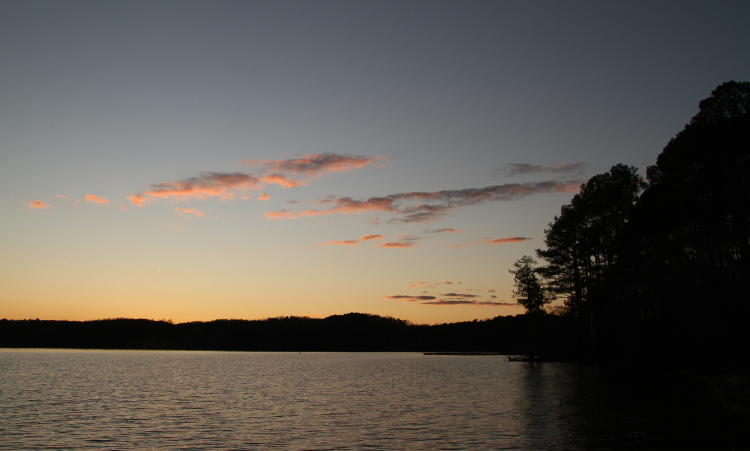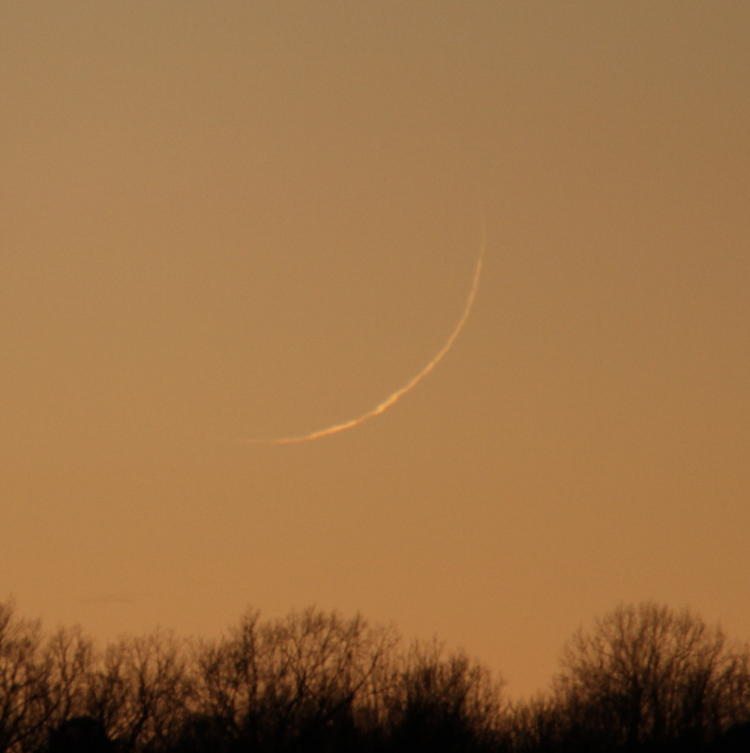It’s about 2:30 AM as I type this – again, my sleep ‘schedule’ is totally wacked and yet, completely typical for me. And knowing that the posting date will show and that some astute reader may refer to this for confirmation of conditions, I feel somehow obligated to refer to events as ‘yesterday’ even though they were a few hours back and all that. But yeah.
Saturday evening. We’d just come out of the cold snap that hit the East a couple days earlier, and heavy downpours less time ago than that, but the sky was clear and the temperature quite reasonable, and I decided to take a chance on the conditions and headed down to Jordan Lake near sunset. There has been little to photograph and fewer personal opportunities to try, and it seemed like a good time. Especially with… but I’m getting ahead of myself.

The sunset was unremarkable due to the clear skies, with just a few orphaned clouds catching some color, but that was encouraging to me. The birds were scarce: a couple of great blue herons doing some distant flights and another example that I’ll get to in a few days. I had idly tracked a light aircraft that went overhead before sunset and, in doing so, suddenly spotted Venus riding high in the sky – it can be visible in daylight, generally with magnification, if you look in precisely the right spot, but it took me a few moments to know that I was seeing a planet and not a very high altitude aircraft catching the sun. And I shot a couple of frames of a cloud throwing a shadow across the humidity in the sky, which presented some small misgivings. Still too far ahead though.

I was out there for a specific reason, and one that might not come to pass at all, but there was perhaps no better time to tackle it – I’d missed plenty of opportunities before. However, you remember this post from two months back, where I captured this tiny sliver of crescent moon as it aged towards new? [I love talking as if there are regular readers of this blog – gives me imaginary validation.] I was curious to see if I could top that and bring it down to less than a day from new. And this has to be done right before sunrise, for a waning (fading) crescent, or right after sunset for a waxing one; the moon will be very close to the sun and so you need the sun to be just over the horizon to eliminate as much glare as possible, and the sky has to be very clear. Two attempts since that post in November had been thwarted by clouds, and I knew this kind of pattern may continue for a while.
And then, there it was.

Knowing where the sun had set helped a lot, because the moon was going to be almost perfectly in line with it (and in fact, there had been a penumbral lunar eclipse two weeks previously when it was full, just not around here, and almost exactly a year ago was the total lunar eclipse.) I had set up the tripod and was scanning the sky in the right region when it popped out at me in the viewfinder; earlier attempts with the binoculars, roughly the same magnification, had yielded nothing, but the sky may simply have been too bright only a few minutes earlier.
Now, as I put up a few more frames, an explanation of the orbital mechanics of all this.

You can’t for instance, simply be out the day before or after the ‘new moon’ [when the moon is completely backlit by the sun and thus invisible to us] and capture the same stage, because the moon’s phases are not perfectly aligned with our Earth days and months. So, on the moon, a mere day (sunrise to sunrise) takes 27 days and 7 hours (43 minutes, 12 seconds,) Earth time, and these are the phases we see. Almost. Because as this is happening, the Earth is revolving around the sun and changing its position, taking the moon with it, so to see the same phase from Earth takes 29 days, 12 hours (44 minutes, 3 seconds.) This was the original definition of a month back in them olden days, and obviously, it presents some problems, most especially the idea that, after a few years, January 1st was falling in the summer. You’ve heard about ‘blue moons,’ which basically means the second full moon in our calendar month? Yeah. So even 29 days from now, at sunset, the phase will be slightly different, but I can’t be bothered to determine if it will be a bigger or smaller crescent right now. [Okay, it should be smaller, and perhaps next to impossible to see without a precisely-aimed telescope.]
In fact, here’s where I’m slightly confused, and I’m trying to do a much-needed post and not study all the celestial mechanics right now. Because my handy LunaSolCal 6.3 app from Volker Voecking Software Engineering told me that new moon was falling Friday (1/24) at 4 PM or so – at least I remember it that way, because I was plotting to try and capture the waning crescent. But as I caught the waxing crescent instead, it told me that the moon was 0.6 days old (so, 14 hours?) and 1 percent visible. I got these photos at about 6 PM on Saturday (1/25,) which to me would mean it was something like 26 hours old, so I’m not sure how long “new” is supposed to last – 12 hours I guess? I don’t know – it’s all a bunch of technicalities, but basically, each month the phase will be different by some hours.

Now, two things to note as we get to this image. The first is the obvious distortion that’s coming from the atmosphere, the same reason I was worried when seeing the cloud shadow on, well, nothing, above – the humidity in the air can obscure a lot. But there’s also something visible in all photos, and that’s this ‘thin’ or darker spot about a third up the crescent from the bottom. This would appear to be caused by a feature of the moon itself, perhaps a lunar mare, but it’s going to be difficult to plot exactly. This is partially because it’s falling right on the edge of the visible portion, so 90 degrees around the face we see, and I’d need a complete global map with meridians to try and pin it down (and since the poles aren’t even distinguishable, the latitude would be just a guess.) And then, there’s libration, the wobble of the moon’s ‘captured’ or synchronized orbit around Earth, meaning that it’s likely not 90 degrees from the center of the visible face, but some presently-unknown variation from it. I’m just not into that at the moment, but perhaps it will spring up later on when I’m still looking for topics to post in the winter.
But while I’m here and have the photo already edited, another demonstration of the distortion from the sky.

As I was scanning the sky a bit earlier, I spotted this medevac helicopter some kilometers off, almost in the same spot as the moon would descend to, and fired off a couple of frames. The distortion is even visible here, and that’s through a tiny fraction of the air between us and the moon, so, yeah. It’s easy to see that even just a bit of a hazy sky would eradicate any chance of seeing the tiny crescent.
Regardless, I’m going to count this as beating the moon shots done in November, if only by a few hours of phase, and consider it unlikely that I will top it without using a telescope. Which might still happen.



















































